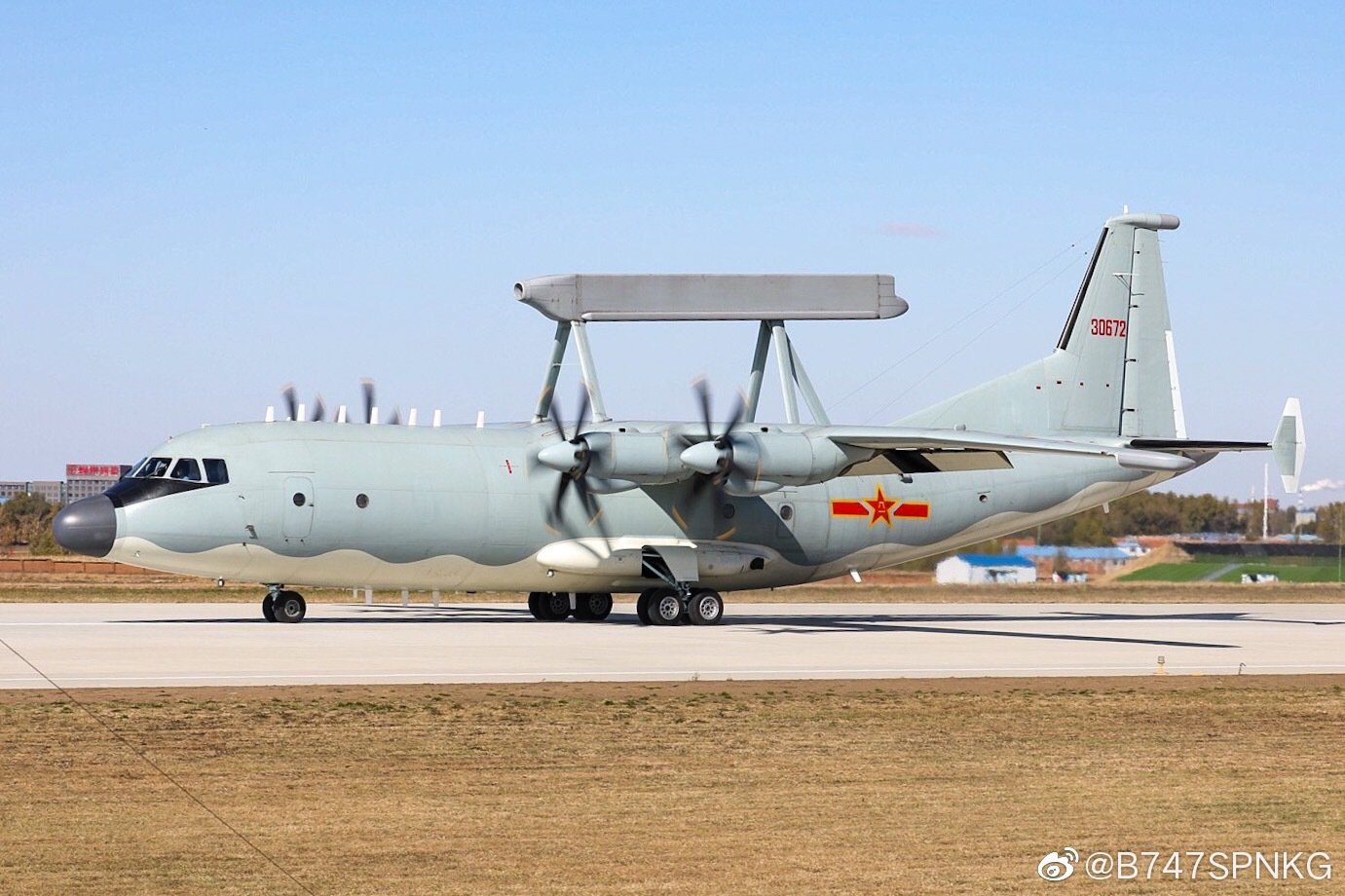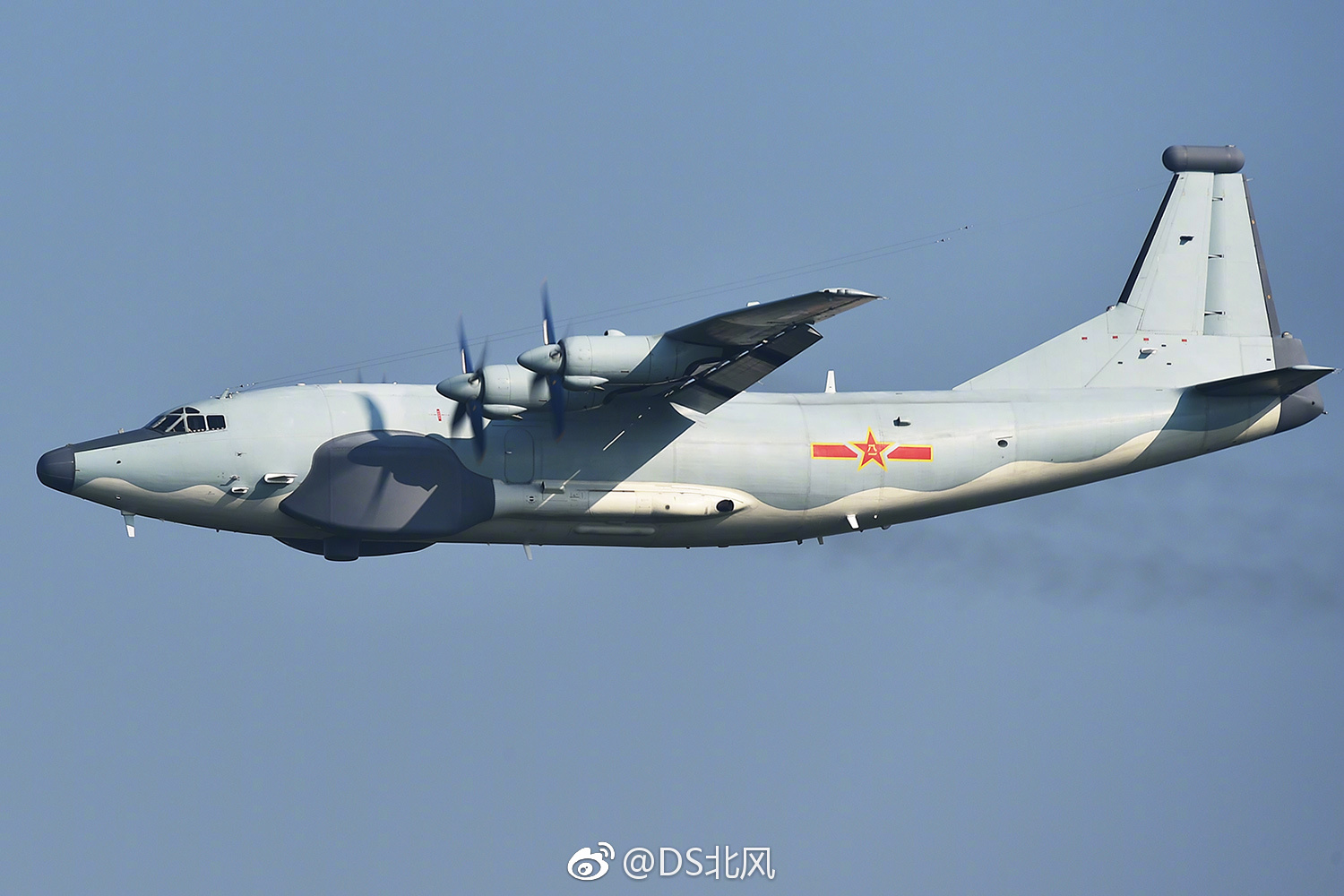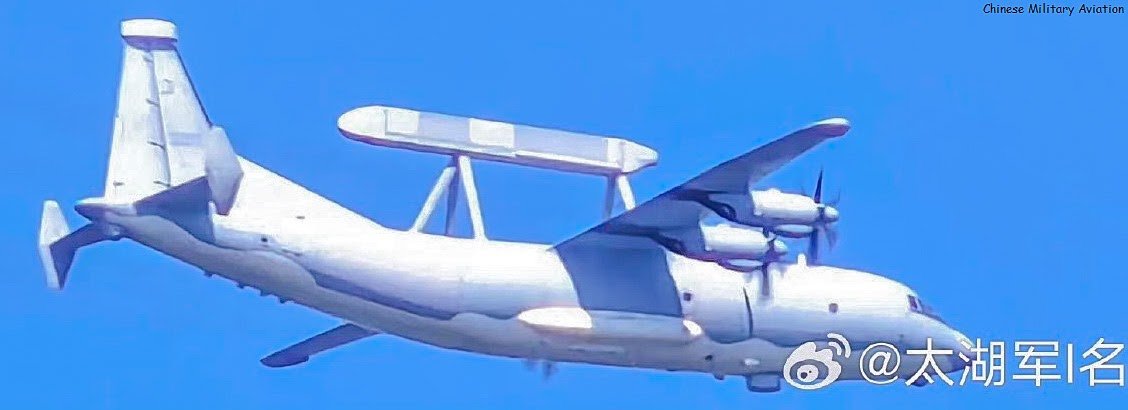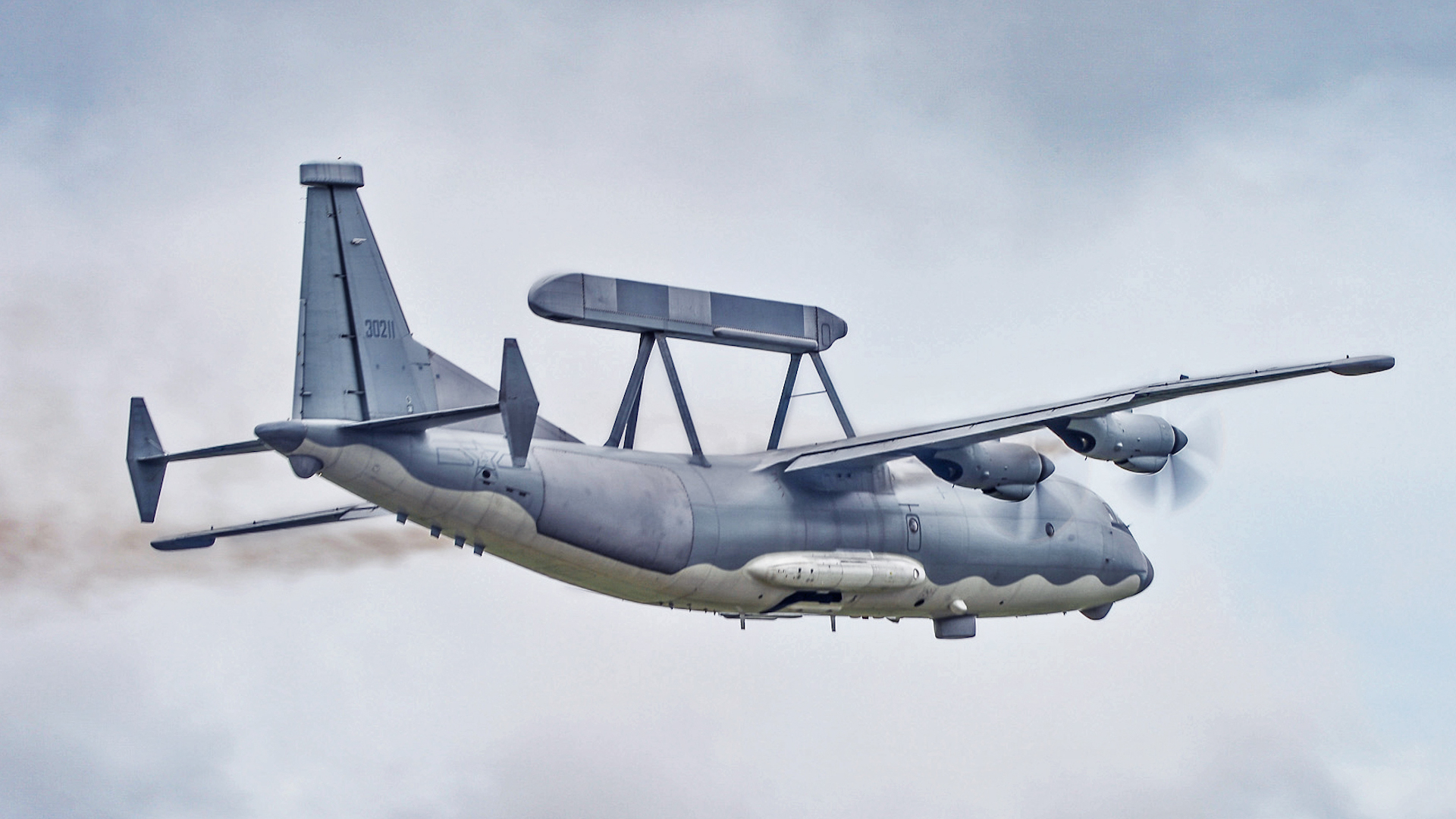Rarely seen in detail before now, China’s Y-9LG electronic warfare platform — understood to be a long-range jamming platform — is taking part in military drills with Thailand, affording observers a much better look at this innovative design. As well as being among the most recent additions to China’s expanding special missions fleet, the Y-9LG continues an impressive line of versions based on the versatile Shaanxi Y-8/Y-9 four-turboprop transport series.
New photos of the Y-9LG have been emerging from Exercise Falcon Strike, joint air force maneuvers involving the People’s Liberation Army (PLA), and the Royal Thai Armed Forces that are currently taking place at Udorn Royal Thai Air Force Base. As well as a Y-9LG, the PLA contingent in Thailand includes a KJ-500 airborne early warning and control (AEW&C) aircraft, J-10C multirole fighters, JH-7A maritime strike aircraft, and tactical helicopters. While the KJ-500, J-10, and JH-7 have been involved in previous Falcon Strike drills, the appearance of the Y-9LG is new.
Alternatively known as the Y-8GX-12, under the ‘High New’ designation series, the Y-9LG was identified in satellite imagery as long ago as late 2017 but has been seen only rarely since then. As of early 2023, however, it was finally reported that the aircraft had entered service with the People’s Liberation Army Air Force (PLAAF).
The operating unit for the Y-9LG is reported to be the PLAAF’s 20th Specialized Division, part of the 58th Air Regiment based at Guiyang-Leizhuang, within the Southern Theater Command. This is responsible for, among others, the highly strategic South China Sea, although it would also likely be involved in any major operation directed against Taiwan.
The most prominent feature of the Y-9LG is the ‘balance beam’ radar antenna mounted above the fuselage, similar to that found on the KJ-200 AEW&C type. However, while the KJ-200 is equipped with a phased-array early warning radar, the Y-9LG’s ‘balance beam’ is understood to contain an array used in an offensive capacity. In this case, it pumps out electronically scanned radar beams to jam enemy radar signals, making the Y-9LG able to execute complex pinpoint electronic attacks against multiple targets over long distances.

Other electronic warfare equipment is found around the Y-9LG’s airframe, including in an enlarged nosecone, presumed to contain another electronic warfare antenna. Fairings on the sides of the rear fuselage likely serve side-looking electronic intelligence or electronic support measures (ELINT/ESM) antennas. Additional ESM antennas are installed below the forward and rear fuselage and also atop the tailfin. The ESM capability allows passive monitoring of radio-frequency transmissions, meaning the Y-9LG can also be employed as an intelligence, surveillance, and reconnaissance (ISR) system, gathering data and geolocating aircraft and ship radars, and land based facilities at extended ranges. Finally, an apparent SATCOM antenna is located on top of the forward fuselage.
Providing this analysis is correct, and there remains some uncertainty about the specifics of the aircraft’s role, the Y-9LG’s wartime mission would be based around disrupting a host of enemy equipment — including command and control communications, radar, and navigation systems — to hamper its activities and, above all, its capacity for battlespace coordination.
Much like the U.S. Air Force’s new EC-37B Compass Call aircraft, which only just entered service, and its EC-130H predecessor, therefore, the Y-9LG would operate from a standoff position, its powerful radar being brought to bear against enemy communications systems, but also for other types of electronic attacks and jamming. With its additional ELINT/ESM sensors, the aircraft would also be able to gather intelligence on a host of threat emitters, which it could detect, track, and geolocate. These sensors could be attacked using potentially highly directional radar beams from its own main antenna or could be handed over to other assets to deal with, including with kinetic attacks, another increasing area of interest for the PLA. There is also the possibility that the Y-9LG will be able to trigger cyber attacks, a growing threat that TWZ has also discussed in depth in the past.

While intended to perform its mission at standoff ranges, there are growing questions about the survivability of platforms of this kind in a high-intensity conflict against a peer-type adversary. After all, the sensors aboard the Y-9LG require a line of sight to the targeted emitter to perform their function. The survivability of the EC-37B, as well, has been a matter of some debate, as high-end long-range air defenses continue to proliferate. That said, the PLA has the relative advantage of operating in its own ‘backyard,’ at least in the example of a conflict in the Asia Pacific region.
The Y-9LG is the latest long-range jamming platform based on the Y-8/Y-9, it’s by no means the first.
The PLA inventory already includes the Y-8GX-3 — based on the earlier Y-8 Category II Platform — which was first identified around 2005. Assigned the Western reporting name Mouse, and also known as the Y-8G, this is a long-range electronic countermeasures aircraft, with prominent ‘hamster cheek’ fairings on the sides of the forward fuselage that likely house antennas that provide standoff jamming capabilities.

The apparent successor to the Mouse is the Y-8GX-11 (alternatively known as the Y-9G) which was first identified in 2014 and is based on the more modern Y-8 Category III Platform, derived from the Y-9 transport. Reportedly, the Y-8GX-11 uses active phased-array radar technology to suppress enemy radar transmissions and communications, with antennas being housed in three large oval and rectangular-shaped fairings on each side of the fuselage. Other antennas are mounted on the tailfin and in a distinctive chin radome, while there are also various blade antennas arranged below the fuselage and semi-spherical antennas below the wingtips.

The Y-8GX-11 is encountered fairly regularly operating near the highly strategic Taiwan Strait, but these aircraft also venture close to Japan and have made deployments to the Spratly Islands in the South China Sea.
Finally, the Y-8GX-13 (also known as the Y-9Z), one of the most modern of the PLA’s special mission aircraft, is also thought to have a standoff jamming function. However, this aircraft is expected to be something closer to a multi-role electronic warfare platform, with other missions likely including electronic intelligence, ground surveillance, and possibly psychological warfare. Starting in 2023, the Y-8GX-13 has been encountered close to Taiwan, but it also operates in the western Pacific near Japan. Only earlier this week, an example was reported as having entered Japanese territorial airspace, in an unprecedented incident you can read about here.

While these various standoff jamming platforms may appear somewhat antiquated, their capabilities should not be underestimated. They also point very clearly to the PLA’s focus on denying the effective use of the electronic spectrum to any of their potential enemies. It’s also clear that the Chinese military is rapidly developing jamming capabilities for its combat jets, both land-based and carrier-based, as well.
Overall, the PLA is developing an increasingly capable and layered set of aerial electronic warfare capabilities paralleling that fielded by the U.S. military. There is a particular emphasis on providing support from standoff distances, complementing tactical aircraft that would be expected to actually penetrate and operate within enemy air-defense bubbles.

At the same time, providing this kind of jamming support from the air is just one aspect of the multi-domain electronic warfare capabilities that the PLA is assembling. Other systems are being developed for ground and sea assets, reflecting the nature of potential combat environments in the Asia Pacific region.
It’s also notable that the Y-8/Y-9 platform, as we have discussed before, lends itself particularly well to operations from more dispersed and even austere bases. Already, the turboprop-powered special missions aircraft routinely appear at some of China’s island outposts, as well as operating regularly in the Taiwan Strait.

When it comes to Taiwan, providing electronic warfare support from the air (as well as on the ground and at sea) would be a key mission in any major Chinese military intervention across the Strait, especially bearing in mind the significant air-defense capabilities that Taiwan can bring to bear.
A larger-scale conflict against other potential adversaries in the broader Indo-Pacific region, such as India or even the United States would also see intense efforts to dominate the electro-magnetic spectrum.
This is something that the U.S. military is well aware of. For example, back in 2021, Secretary of the U.S. Air Force Frank Kendall specifically warned that electronic warfare capabilities were one of the areas of the PLA’s focus. He observed that China has been “increasing inventory levels and the sophistication of their weapons and modernizing redundant systems throughout the kill chains that support their weapons.” This huge Chinese investment in airborne standoff ISR also includes AEW&C, leading to a diverse and growing fleet that we have profiled in the past.
While the exact capabilities of the Y-9LG remain mysterious, as befitting its shadowy electronic warfare mission, its appearance in a bilateral exercise signifies not only its importance in a variety of potential scenarios but also reflects, more broadly, the PLA’s strong emphasis on fielding new, robust electronic warfare capabilities as it continues its modernization drive.
Contact the author: thomas@thewarzone.com
